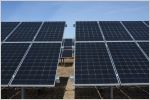Published in Calgary Herald (July 18, 2007)
Alberta's wind-energy industry — until recently Canada's undisputed leader — is being systematically blocked by short-term transmission bottlenecks, a long-term cap on production and an obvious lack of leadership to solve either problem.
While Alberta is in need of new electricity sources and to reduce its oversized environmental footprint, it is difficult to fathom why an industry that can provide both is being held back.
Renewable energy is in the midst of a global boom. In 2006 both wind and solar power experienced growth rates of over 30 percent for the tenth consecutive year. Jurisdictions currently fostering these technological revolutions are also the major exporters of these technologies and their early investments will generate escalating returns as the rest of the world — including Alberta — makes the inevitable transition to renewable energy.
Denmark already harvests 20 percent of its electricity from the wind and is aiming for 50 percent in the coming decades. Germany, meanwhile, leads the world in wind power installations and last year alone commissioned almost as much new solar capacity as Canada gained from wind in the last decade.
Here at home, there are many examples of provinces showing leadership such as Ontario who recently adopted a similar approach to Germany, encouraging renewable energy deployment. Quebec has committed to developing over six times the amount of wind power now produced in Alberta. British Columbia has declared that all new electrical power development will be carbon neutral.
Alberta, however, has distinguished itself as the only jurisdiction in North America to cap the growth of this burgeoning sector.
Astonishing? You bet — and more so when you consider the "Alberta wind advantage". Not only do we have world-class reserves of wind, our province became home to Canada's first wind farm in 1998, and still has several of Canada's largest wind installations. Sadly, however, Alberta failed to anticipate the need for transmission upgrades in time to exploit its wind advantage. The southern corridors of our electricity network are gridlocked stranding billions of dollars of wind energy investments.
Claude Mindorff, President of WindWindeau Inc., estimates that at least 3,000 megawatts (MW) of electricity and a minimum of $6 billion of investment in Alberta wind energy is now on hold.
Negotiating with landowners and local residents is an important and time-consuming step in upgrading transmission and has been a big reason for the delays to date. However, due to a lack of planning and foresight, generators (including wind and natural gas) hoping to come on-line cannot.
When the transmission upgrades eventually happen, the wind industry's short-term problem will likely be replaced by a more serious long-term barrier: the 900 MW cap imposed in 2005. The cap was imposed by the Alberta Electric System Operator (AESO) owing to fears that it might not be capable of handling fluctuations in wind power.
These fears, however, are largely unfounded; a recent study completed for the Canadian Wind Energy Association and the AESO found that winds rise and fall gradually, and fluctuations can be predicted and planned for in this province, as jurisdictions such as Germany and Denmark have already found.
There are many ways to smooth the peaks and valleys of wind-generated electricity: through forecasting, geographically spreading out renewable projects, increasing integration with hydro systems, having dispatchable system loads, local energy storage, education and experience of the system operators and so on. Not all of these options may be economic in the short term, but they are solutions the world is going to need and there is no reason that we cannot develop them here in Alberta.
While wind power is different from that of conventional sources, our engineers and planners are certainly capable of finding new ways to incorporate more renewables into the generation mix in Alberta's grid.
It should be noted that many of Alberta's top oil and gas company's including Alta Gas, Enbridge, Nexen, Shell and Suncor have made investments in wind and some of their projects are stalled because of either lack of transmission or the 900 MW threshold.
Contrast Alberta's leadership vacuum with Prince Edward Island who recently released their Renewable Energy Strategy with a goal of achieving 100 per cent renewable electricity by 2015. Developing local, sustainable, and more environmentally-sound sources of energy is not only of pressing importance to Alberta — it is arguably the most important issue facing the world. We are well positioned to do this, the investors are waiting, the public supports it — the only question is: will Alberta's leaders have the vision and strategy to put wind in our sails?
Tim Weis is a Community Energy Analyst with the Pembina Institute. More information is available from www.pembina.org
Dr. Tim Weis was the director of the Pembina Institute's renewable electricity program until 2014.



